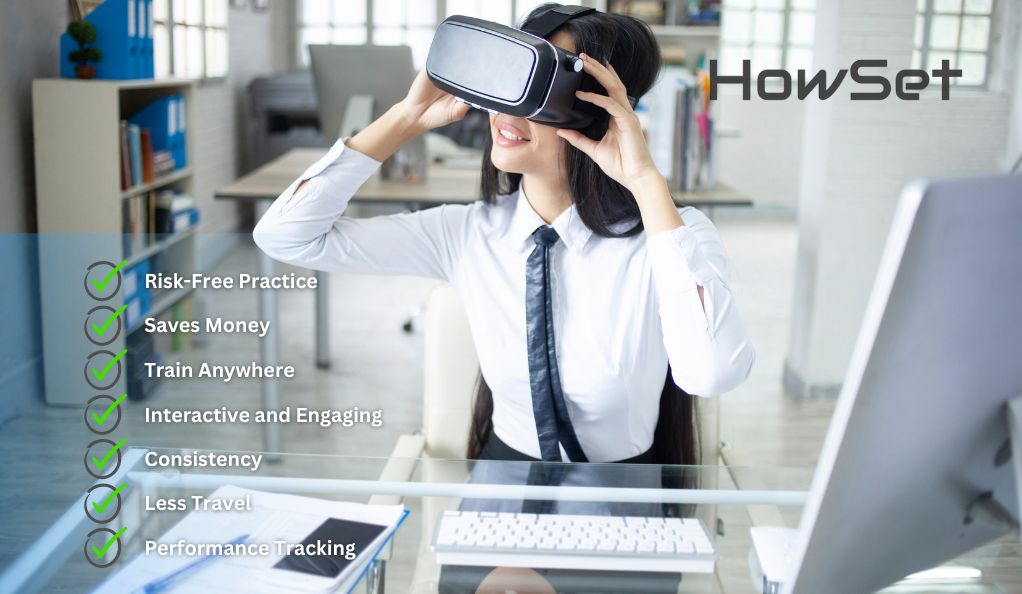VR in Workplace Training: Essential Benefits Explained
In today’s fast-paced business world, training employees effectively is more important than ever. That’s where Virtual Reality (VR) comes in, offering a fresh and powerful way to train people at work. VR training is not just a trend; it’s a game-changer in how we learn and grow professionally.
Imagine putting on a VR headset and suddenly, you’re not just learning about a task, you’re doing it. This is the magic of VR training. Whether it’s practicing safety procedures, customer service, or technical skills, VR provides a safe, realistic environment for employees to learn by doing.
What makes VR training stand out? It’s the way it engages learners, making complex training scenarios easy to understand and remember. This technology is not just for tech giants or big corporations. Businesses of all sizes are starting to see how VR can make their training programs more effective and memorable.
The Advantages of VR in Workplace Training

Virtual Reality (VR) is not just for gaming or entertainment; it’s a powerful tool in the world of professional training. Let’s break down how VR is changing the game for workplace training.
Safe and Controlled Learning Environments
- Risk-Free Practice: In VR, employees can practice risky tasks without actual danger. For instance, a firefighter can learn to tackle fires in a virtual world before facing real flames.
- Real-World Scenarios: VR creates lifelike situations. This means people can learn how things work in the real world, but in a safe, virtual space.
Cost-Effective Training Solutions
- Saves Money: Traditional training can be expensive, needing equipment, space, and travel. VR cuts these costs, as all you need is a headset and software.
- Reduces Training Time: VR makes learning faster because it’s so engaging. This means employees can get back to work quicker, saving time and money.
Remote Training Capability
- Train Anywhere: With VR, location isn’t a problem. Employees can train from anywhere, which is perfect for remote teams or those working from home.
- Flexibility: It fits into any schedule. Employees can train when it’s best for them, leading to better learning outcomes.
Enhanced Learning Experience
- Interactive and Engaging: VR is hands-on and interactive, making learning fun and memorable.
- Better Retention: When training is engaging, people remember it better. VR’s immersive experience helps employees retain information more effectively.
Standardized Training Across Teams
- Consistency: VR ensures that every employee gets the same training experience. This is crucial for maintaining standards across different locations and teams.
- Customizable: VR programs can be tailored to meet the specific needs of different teams within a company.
Environmental Benefits
- Less Travel: Remote VR training means less travel, which is good for the planet.
- Reduced Material Use: With VR, there’s no need for printed materials or physical equipment for training, reducing waste.
Data-Driven Insights
- Performance Tracking: VR systems can record how well employees do in training sessions. This helps in giving them personalized feedback.
- Improves Training Programs: The data collected can help companies make their training even better over time.
VR in workplace training brings a host of advantages. It’s safe, cost-effective, flexible, and provides a rich learning experience. Plus, it’s environmentally friendly and offers valuable insights through data collection. As we move into the future, VR is set to become an essential tool in training and developing a skilled workforce.
VR Training in Action: Case Studies
Seeing is believing, and nothing shows the power of VR training better than real-life examples. Let’s look at some case studies where VR made a big difference in workplace training.
Case Study 1: Retail Giant Walmart
- Challenge: Walmart needed to train employees quickly on new technology without disrupting store operations.
- VR Solution: They used VR to simulate the in-store environment, allowing employees to practice without impacting customers.
- Results: Training time reduced from 8 hours to 15 minutes per employee. Workers felt more confident and were ready to use the new system much faster.
Case Study 2: Healthcare Training for Surgeons
- Challenge: Surgeons need lots of practice, but it’s hard to get without risking patient safety.
- VR Solution: VR simulations were created for surgeons to practice operations.
- Results: Surgeons got hands-on practice in a risk-free environment. They improved their skills and confidence without any danger to patients.
Case Study 3: Automotive Industry – Ford Motor Company
- Challenge: Ford wanted to improve their design process and make it more efficient.
- VR Solution: Designers and engineers used VR to create and test car models in a virtual space.
- Results: The process became faster, and it was easier to spot and fix design issues early on. This saved time and money in the car design process.
Case Study 4: Virtual Firefighter Training
- Challenge: Firefighters need to train in dangerous situations, but it’s risky and expensive.
- VR Solution: Firefighters used VR to simulate real fire scenarios, learning to handle various emergencies.
- Results: Firefighters trained in a safe, controlled environment. They were better prepared for real-life situations, improving their performance and safety.
These case studies show that VR can transform training across different fields. From retail to healthcare, automotive to emergency services, VR offers a practical, safe, and efficient way to develop skills and improve job performance. It’s clear that VR is not just the future of training; it’s already making a big impact right now.
Challenges and Considerations in VR Training

While VR training brings exciting opportunities, it’s not without its challenges. Acknowledging and understanding these hurdles is crucial for businesses to effectively implement VR training solutions.
Initial Investment and Ongoing Costs
One of the biggest challenges is the cost associated with VR training. This includes not only the initial investment in VR headsets and software but also ongoing expenses for maintenance and updates. These costs can be significant, especially for smaller businesses. Additionally, the VR technology landscape is constantly evolving, which means companies need to regularly invest in keeping their systems up-to-date.
Technical Challenges and User Comfort
Another important consideration is the ease of use and comfort of VR technology. Not all employees are comfortable with high-tech solutions, and some might find it challenging to adapt to VR training. Moreover, using VR headsets for extended periods can cause physical discomfort or dizziness in some users. Therefore, it’s important to ensure that VR sessions are user-friendly and include regular breaks to prevent fatigue.
Training Content Development
Developing effective VR training content is a complex task that requires specific skills and expertise. Creating immersive and engaging content that accurately simulates real-world scenarios is time-consuming and often requires a significant investment. Moreover, as job roles and technologies evolve, the VR content needs to be regularly updated to stay relevant, adding to the ongoing costs.
Integration with Existing Training Programs
Integrating VR training into existing training programs presents its own set of challenges. VR should complement, not replace, traditional training methods. This requires careful planning to ensure a blended learning approach that maximizes the benefits of both VR and traditional training. Additionally, the VR system must be compatible with the company’s existing training and IT infrastructure to ensure a seamless integration.
Measuring Effectiveness and ROI
Measuring the effectiveness of VR training and its return on investment (ROI) is crucial. Companies need to establish metrics to assess how VR training impacts employee performance and skill development. This involves looking beyond the novelty of VR and evaluating its tangible benefits in comparison to its costs. Understanding these metrics is essential for businesses to determine whether VR training is a financially viable solution for their training needs.
The Future of VR in Workplace Training
The future of VR in workplace training looks bright and full of possibilities. As technology advances, VR is set to become more common and even more effective as a training tool.

Broader Accessibility and Lower Costs
In the future, we can expect VR technology to become more accessible to a wider range of businesses. As the cost of VR equipment drops and software becomes more user-friendly, even small businesses will be able to take advantage of VR training. This wider accessibility will open up new opportunities for companies of all sizes to train their employees in innovative and engaging ways.
Advanced Customization and Realism
VR technology will continue to advance, allowing for even more realistic and immersive training experiences. The development of custom VR content will become easier and more cost-effective, enabling businesses to tailor training programs specifically to their needs. This increased realism and customization will make VR training even more effective, as employees will be able to practice and learn in environments that closely resemble their actual work settings.
Integration with Other Technologies
We can also anticipate that VR will increasingly be integrated with other emerging technologies like artificial intelligence (AI) and augmented reality (AR). This integration will create more interactive and adaptive learning experiences. For example, AI could be used to adjust the training program in real-time based on the learner’s performance, making the training more effective and personalized.
Wider Range of Applications
As VR technology evolves, its applications in workplace training will also expand. Beyond its current uses, VR could be used for a wider range of training scenarios, including soft skills development, leadership training, and more complex technical skill acquisition. This versatility will make VR an indispensable tool in the toolbox of training professionals.
Greater Focus on Data and Analytics
Finally, the future of VR in workplace training will see a greater focus on data and analytics. With advanced tracking and reporting features, businesses will be able to gather detailed insights into employee performance during training. This data can be used to further refine training programs, making them more effective and tailored to the needs of the workforce.
Conclusion
In conclusion, VR in workplace training is a groundbreaking development, reshaping how we approach professional learning and development. From offering safe and controlled environments to providing cost-effective, engaging, and customizable training solutions, VR has proven its value across various industries. While challenges like initial costs and integration exist, the future of VR in training is bright, promising more accessible, advanced, and data-driven training methods. As we look ahead, it’s clear that VR will not only enhance the efficiency and effectiveness of training programs but also transform them into more immersive, interactive, and impactful experiences, ultimately fostering a more skilled and prepared workforce.


Leave a Reply